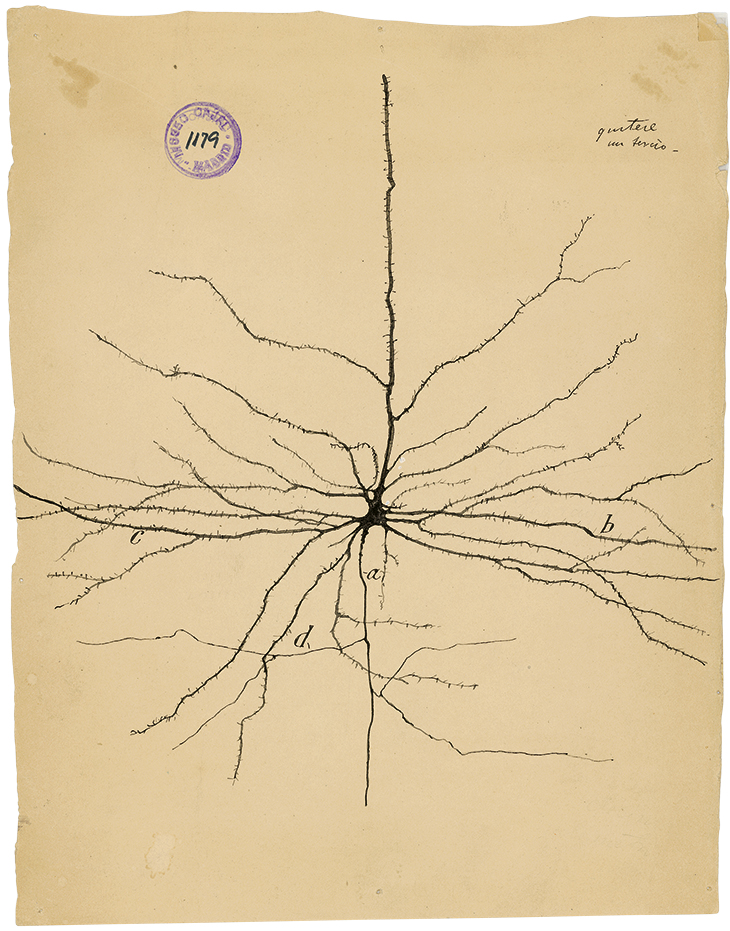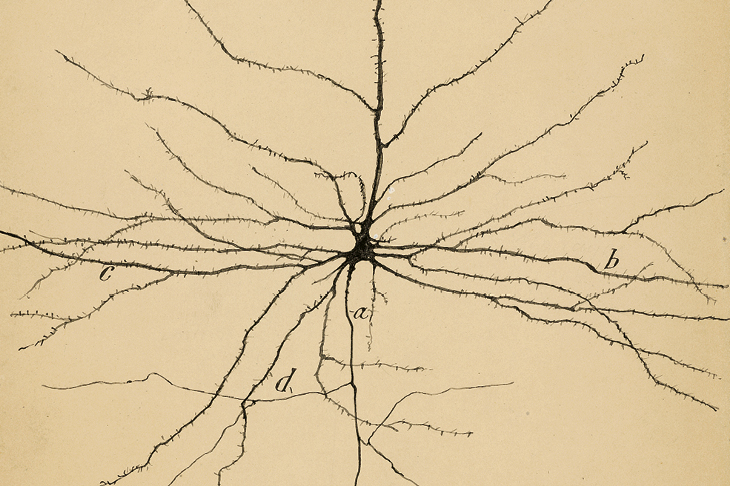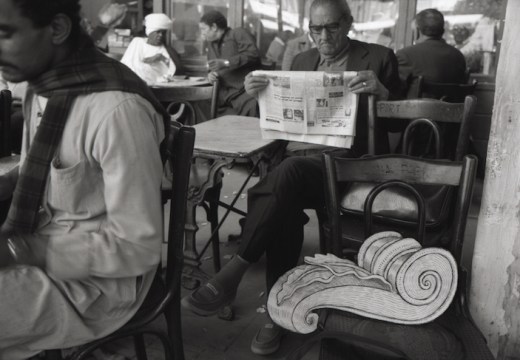In 1873 the Italian physician Camillo Golgi published the first images of nerve cells made using his new silver-chromate technique. Golgi’s method, which stained cells so that they could be seen individually under a microscope, exposed the inner workings of the brain in unprecedented detail, ushering in a new age of biological and psychological research. But it also contributed to an aesthetic revolution. Santiago Ramón y Cajal, the scientist and talented draughtsman who refined Golgi’s method and shared the Nobel Prize with him in 1906 (the two disliked each other intensely, and nearly came to blows on the winner’s podium), described seeing individual neurons for the first time as a moment of artistic as well as scientific revelation. ‘What an unexpected sight!’ he wrote later of the experience, ‘[s]parse, smooth and thin black filaments, or thorny, thick, triangular, stellate, or fusiform black cells could be seen against a perfectly translucent yellow background. One might almost liken the images to Chinese ink drawings on transparent Japanese paper.’
For Cajal the visualisation of the neuron confirmed two hunches: that the central nervous system consisted of separate nerve cells, or neurons, rather than a single mass of ‘reticulated tissue’, and that these individual neurons were separated from one another by a ‘synaptic gap’: a space through which impulses passed in chemical, rather than electrical, form. Golgi’s technique had thrown, as T.S. Eliot later wrote in ‘The Love Song of J. Alfred Prufrock’, ‘the nerves in patterns on a screen’, and in doing so it enshrined the neuron as the fundamental unit of consciousness in the scientific and popular imagination. Just as the model of the atom revolutionised physics, so the discovery of the neuron would go on to provide a conceptual building block for the new cognitive sciences. It also promised to unlock the mysteries of how visual perception, and aesthetic pleasure, might best be understood. Since then art theorists have often been tempted to appeal to the authority of neuroscience in order to explain how and why artworks make us feel the things they do.
Attempts to objectivise the study of aesthetics along scientific lines began in earnest around the time Golgi and Cajal first isolated the neuron. In Germany in the 1870s the philosopher Gustav Fechner invented the field of what he called ‘experimental aesthetics’, with which he hoped to establish an empirical psychology of beauty. Fechner’s theories were founded on the idea that aesthetic responses could be measured using experimental means, and that beauty had more to do with the relationship between art and the brain than it did with that between art and the world.
Fechner’s project coincided with a pronounced and general ‘inward turn’, associated in psychology with the rise of Freudianism and in the visual arts with Impressionism and its children: a rejection of solid representations of the material world in favour of a profound psychologisation of artistic processes, subjects and styles. Paul Cézanne’s influential aphorism, that ‘painting from nature is not copying the object, it is realising one’s sensations’, was modified by Pierre Bonnard, in more scientific language, when he asserted that his works were merely transcriptions ‘of the adventures of the optic nerve’.
A tendency to locate aesthetic pleasure not in the world but inside the body and brain became a mainstay of early 20th-century art criticism. Freudian psychoanalysis provided one model of the way in which meanings could lie buried beneath the surface of a painting; the rise of neurology provided another, one that was for many critics equally compelling. What might be called the ‘material unconscious’, explored by biologists and neuroscientists, was a realm made up of blind behaviourist processes: neuronal impulses and the push-pull of stimulus response of the nervous system.
In Britain, Roger Fry and Clive Bell would bang the drum for Post-Impressionist abstraction by invoking the notion of ‘significant form’ to suggest that beauty had little to do with a painting’s purported ‘meaning’, but instead depended on a somewhat vague suite of internally derived (and largely incommunicable) formal characteristics. By the 1950s, Clement Greenberg would declare that the advances associated with the Abstract Expressionists of the New York School had given rise to an art designed not for whole people but for ‘eyesight alone’. For Greenberg, Pollock’s action paintings were the products of the dumb movements of the nervous system once liberated from the executive ego. Rothko’s overwhelming canvases were attempts to portray colour as it might be seen without a self. Such paintings were to be read by the nerves in isolation rather than the minds which beheld them.
This tendency – to think both of the production of art and its interpretation solely in terms of brain processes – reached a crescendo at the end of the 20th century. Since the 1990s, hubristically declared by George Bush Snr to be the ‘decade of the brain’, academics have become increasingly interested in asking whether neurobiology can help us understand not just what art does to us, but how it is we might be helped by it.
The term ‘neuroaesthetics’ was coined in 1999 by Semir Zeki, who is now professor of this fledgling field at University College London. Zeki’s argument was not that neuroscience could necessarily teach us about art, but that art could teach us something about the working of our brains, and how and why they generate aesthetic experiences. By placing people in fMRI scanners and studying how various neural areas associated with visual processing responded to different images, Zeki believed we might discern universal and essential truths about the structure of the nervous system.
What’s striking about the development of neuroaesthetics as an academic discipline over the past 20 years is that it has for the most part followed the same reductive imperative as that which gave rise to modernist abstraction in the first place. As the Nobel Prize-winning scientist Eric Kandel argues in a recent book, Reductionism in Art and Brain Science (2016), the localising aims of neuroscientific inquiry – the desire to identify certain areas of the brain as being responsible for (or, in some extreme formulations, being identical with) certain kinds of visual and emotional experiences – also underpin the aesthetics of much 20th-century art. Just as Golgi’s method gave rise to a neuroscientific project which sought to chase the mind into ever smaller parts of the brain, argues Kandel, so too did many painters and aestheticians from the period focus their attention on trying to pin down the smallest parts of visual sensation they could work with in isolation: the impression, the line, the plane.
More recent interventions in the field have built on Zeki’s observations to argue for the diagnostic or therapeutic qualities of the arts, or their practical role, in evolutionary terms. On these readings, the experience of beauty is reinterpreted, along neo-Darwinian lines, as having ‘adaptive value’ of some kind – we feel that certain things are beautiful, that is, because they give us some evolutionary advantage. Figurative paintings that portray relationships between people are good for us, argues Lisa Zunshine, because they give our ‘theory of mind’ – our supposedly uniquely human ability to imagine the rich internal lives of other people – a ‘rigorous workout’. Such works, she has argued in Getting Inside Your Head (2012), are evolutionarily useful because they train us to be more empathetic, socially minded beings. But if art is to be valued merely because it teaches us to be good ‘mind readers’ – able to understand intuitively the thoughts and feelings of those around us from their outward behaviour – the question of why we should decide to use these powers for good (to empathise more) rather than for ill (to manipulate those within our social group) is one that hasn’t yet been satisfyingly answered.

The Pyramidal Neuron of the Cerebral Cortex (1904), Santiago Ramón y Cajal. Photo: Courtesy of the Cajal Institute, Cajal Legacy, Spanish National Research Council (CSIC), Madrid, Spain
For Kandel the rise of Abstract Expressionism can be understood in similarly evolutionary terms: such works provide, he argues, a means of priming our visual systems to recognise and process novel visual experiences. On this reading the canvases of Rothko and Pollock are important precisely because they don’t represent anything very much. ‘The best-known abstractionists,’ he says, were engaged in a project of creating ‘new rules for visual processing.’
A parallel approach within neuroaesthetics has been to argue not that works of art represent the culmination of universal evolutionary tendencies, but that artists are themselves outriders of empirical enquiry, proto-scientists who in their work often stumble on scientific breakthroughs long before they can be confirmed by the cold observations of the experimenter. Thus according to the popular science writer Jonah Lehrer, in Proust was A Neuroscientist (2007), we should value Cézanne and the Post-Impressionists not because their paintings bring us pleasure but because their abstracted visual language modelled how our brains themselves process optical information, an observation made long before neuroscientists embarked on their forays into similar territory.
These kinds of argument have the immediate, seductive allure of just-so stories, and it’s not surprising that they continue to be popular. In a recent collection of essays, Bacon and the Mind (2019), Zeki and Tomohiro Ishizu take a neurobiological approach to understanding the work of Francis Bacon, arguing that the ‘visual shock’ of Bacon’s grotesque bodies is caused by the way he subverts ‘the brain’s inherited concepts of what bodies and faces should look like’. The recognition of bodies and faces depends on dedicated areas of the brain, centred on ‘an area located in the fusiform gyrus’ called ‘the fusiform face area’, damage to which leads to the development of ‘prosopagnosia’: an inability to perceive or recognise faces. According to Zeki and Ishizu, certain automatic processes within these ‘face recognition systems’ are subverted in Bacon’s work. His paintings, they argue, appeal directly to these brain systems before we are even aware of what it is that’s being represented.
What all these projects share is a belief in an objective science of art criticism, in which beauty or sublimity can be neatly reduced to brain processes, and art often serves instrumental purposes. If this strikes you as a rather bleak defence of the arts you would not be alone. Quite what critical insights can be gained from them remains obscure, too. Bacon’s paintings may derive their power from the fact that the figures they represent look like grotesquely modified faces and bodies, but I’m not sure why we need neuroscience to tell us this.
Many of the recent redevelopments in the story of the relationship between art and the brain have been criticised as constituting what the physician and writer Raymond Tallis has identified as ‘neuromania’: a tendency to privilege neurological and evolutionary interpretations of value over cultural ones. But it’s comforting to think that these are not new anxieties. In 1949, Lionel Trilling warned of the ‘reductive spectre’ of psychoanalysis, which, he said, ‘haunts our culture’. Just as no one is now seriously concerned that the language of ‘libidinal impulses’ and ‘erotic drives’ will replace that of romantic love – that such language constitutes, as Trilling feared, ‘a threat to the emotions and thus to life itself’ – so it seems unlikely that the language of nerves and neurons will ever fully replace our intuitive, messy, and instinctive vocabulary of aesthetic criticism. Studying brains can only tell us so much about the meaning of beauty.
From the April 2019 issue of Apollo. Preview and subscribe here.
Unlimited access from just $16 every 3 months
Subscribe to get unlimited and exclusive access to the top art stories, interviews and exhibition reviews.














![Masterpiece [Re]discovery 2022. Photo: Ben Fisher Photography, courtesy of Masterpiece London](http://www.apollo-magazine.com/wp-content/uploads/2022/07/MPL2022_4263.jpg)
It’s time for the government of London to return to its rightful home